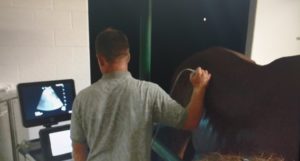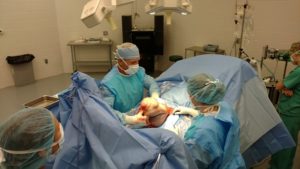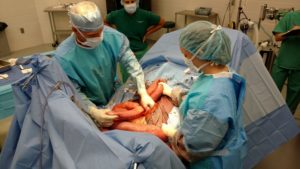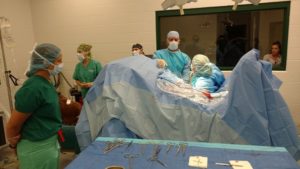Ernie’s Colic Surgery, part 2
When last you, my adoring fans, heard from me, Ernie was about to get on a horse trailer headed for Equine Medical Center of Ocala (EMCO). This week, you get to hear all about surgery. All I have to say is, there are a whole lot of guts inside a horse! And now, the rest of the Ernie colic story.
Tony: OK, so you have decided to take Ernie to surgery. What are you thinking as you load him on the trailer?
Dr. L: Lots of people worry about horses going down in the trailer. I wasn’t worried about that for a few reasons: 1) I didn’t tie him, so if he went down, he wasn’t stuck with his head at a weird angle, 2) I gave him a bit of sedation right before we left to help him stay as comfortable as possible, 3) We gave him plenty of room in the horse trailer so that if he went down, he had room to get up.
What I was worried about was the hour it takes to get to EMCO, and if he was going to be painful when we got there, or if he was going to have what we call a ‘therapeutic trailer ride’, and be all better. Some people feel embarrassed when their horse is all better after a trailer ride to the clinic. DON’T!!! As veterinarians, we are very happy for you! I wasn’t that lucky.
Tony: What happens when you arrive at a referral hospital like EMCO with a colic? Do they whisk them off to surgery? Are there alcoholic beverages to calm the humans? Do they have a cat to offer up a superior opinion on the matter?
Dr. L: Well, that’s a lot of questions! The first thing they do is decide if this is a surgical colic, and how sick is Ernie. Sure, I said it’s highly likely he’s surgical, but they want to make doubly and triply sure, and I agreed! I didn’t want to put Ernie through surgery if I didn’t have to!! Ernie was placed in stocks, and many of the things I did were repeated. The ultrasound showed several more loops of unhappy small intestine, rectal palpation was still normal, and his bloodwork still looked good. That meant Dr. Adams and I had to have a serious talk about surgery.
 Both of us felt it was very likely that Ernie did in fact have an epiploic foramen entrapment, surgery was almost definitely needed, but there was a small chance he didn’t need it. Given that both of us felt surgery was inevitable, and small intestine doesn’t like to be unhappy for very long, I said yes to surgery. At this point, there were no alcoholic beverages, but in hindsight, I should have started myself on anti-ulcer medication. As to the cat, not every clinic is as lucky as Springhill Equine to have an amazing cat like you, so we had to go with the human opinion only, knowing it was inferior to a quality cat scan.
Both of us felt it was very likely that Ernie did in fact have an epiploic foramen entrapment, surgery was almost definitely needed, but there was a small chance he didn’t need it. Given that both of us felt surgery was inevitable, and small intestine doesn’t like to be unhappy for very long, I said yes to surgery. At this point, there were no alcoholic beverages, but in hindsight, I should have started myself on anti-ulcer medication. As to the cat, not every clinic is as lucky as Springhill Equine to have an amazing cat like you, so we had to go with the human opinion only, knowing it was inferior to a quality cat scan.
Tony: Eeek, surgery… That just sounds scary!
Dr. L: It is and it isn’t. I knew Ernie had a serious problem, but wasn’t systemically sick yet. I also knew the longer I waited, the more likely he was to get sicker. More importantly, I knew that if the small intestine got worse, and he was an epiploic foramen entrapment, surgery would be much, much riskier. I also had thought about all of this before it was necessary. One thing this job has taught me is to be prepared for my horse to do something very expensive, at a bad time, that requires a quick yes or no decision from me. I know without a doubt I will do colic surgery on Ernie and Vespa. I’m pretty sure I won’t do it on the rest of them, for a wide variety of reasons. The point is, I’ve thought about it, and I’ve thought about how I’m going to pay for it.
Tony: Payment, that sounds really scary. You didn’t offer me up, right?
Dr. L: First, you are priceless, so no, I didn’t offer you. Second, there are a few options when it comes to how to pay for this sort of thing. Insurance can be a great option. You have to insure for at least a certain amount for mortality, then add on major medical and surgical. Colicare from SmartPak is also a great option. You purchase a supplement from SmartPak, and they give you up to $7500 in colic insurance. That covers the cost of an average colic surgery (this one came in at about that price). Or, you can go with what I did, which is to have a savings account with the money for an expensive injury, colic surgery, or illness tucked away somewhere hard to get to.
The point is, you need to have a plan before it happens!! Making these decisions when someone is telling you your horse needs surgery or euthanasia is extremely difficult! Write these decisions down somewhere that others can find them as well, in case you are out of town when the call needs to be made.
Tony: OK, decision made. Now surgery….How does that even work?
Dr. L: First Ernie got an IV catheter so medication and fluids could be easily given during surgery. Next, he got antibiotics prior to surgery, to help prevent infections. Then he was taken into what’s called the induction stall. This is a smallish padded stall where he was sedated heavily, then given Ketamine to fully anesthetize him. You’ll hear human anesthetists say ‘put to sleep’ in this situation. Us veterinarians don’t like that terminology so much, for obvious reasons.
 Once he was completely asleep, straps were placed around his feet, and he was picked up with a hoist, and placed on a surgery table. Once there, the surgery team went to work fast to clip and scrub his belly, sew his sheath shut, and get anesthesia monitoring stuff set up.
Once he was completely asleep, straps were placed around his feet, and he was picked up with a hoist, and placed on a surgery table. Once there, the surgery team went to work fast to clip and scrub his belly, sew his sheath shut, and get anesthesia monitoring stuff set up.
Tony: Whoa! They sewed his sheath shut?! And what’s the other stuff?
Dr. L: Yeah, you have to sew the sheath shut to prevent urination into the surgery area. No way around that, and urine in the surgical field is generally considered less than ideal.
And the other stuff. Horse bellies are pretty dirty places, even in the best of circumstances. Add in a horse who has been down and rolling from colic pain, and they are even dirtier. This means there’s a lot of scrubbing involved to get them super clean. While the scrubbing is happening, an arterial blood pressure monitor, a heart rate monitor, and the anesthesia machine are all being hooked up to make sure Ernie stays asleep, but not too asleep, during surgery. It’s really, really important to monitor anesthesia closely. It’s one of many ways surgery is a much safer option for horses than it was 20 to 30 years ago.
Tony: And now to surgery.
Dr. L: Yep, now to surgery. Ernie got one final scrub in the surgery room, then Dr. Adams and Dr. Hicks draped him. Draping basically means he was covered in big, sterile sheets so the doctors had a sterile place to put all the guts that were about to come out of his abdomen. Once they finished that, it was the moment of truth: the incision.
 You have to be careful making these incisions, since there can be gas-filled GI tract pushing up from the inside. The first thing Dr. Adams looked for after making the incision was the cecum. The cecum is the landmark you use to find all the other parts of the bowel, so it’s pretty important. Dr. Adams followed the cecum to the small intestine, and announced that Ernie did indeed have an epiploic foramen entrapment.
You have to be careful making these incisions, since there can be gas-filled GI tract pushing up from the inside. The first thing Dr. Adams looked for after making the incision was the cecum. The cecum is the landmark you use to find all the other parts of the bowel, so it’s pretty important. Dr. Adams followed the cecum to the small intestine, and announced that Ernie did indeed have an epiploic foramen entrapment.
Here’s where the ‘curse of knowledge’ kicked in for me. I was now nervous, and would get to stay that way for 45 excruciating minutes. This type of surgery requires Dr. Adams to work the 17 feet of intestine that Ernie had trapped back into the abdomen through a very tiny hole. The risk of tearing the intestine or a blood vessel is  pretty high, and it stays that way until the moment the last of the intestine is through the hole.
pretty high, and it stays that way until the moment the last of the intestine is through the hole.
 I also got to watch poor Dr. Adams spend 45 minutes bent over my horse’s abdomen at a horribly awkward angle, which was killing his back. It was all worth it though. At the end of that very long time, the intestine was free, and looked pretty ok. It was bruised and a little battered, but none of it was dead or even compromised, which meant none of it had to be removed. That is what getting a horse to surgery quickly does: it keeps the intestine happy!
I also got to watch poor Dr. Adams spend 45 minutes bent over my horse’s abdomen at a horribly awkward angle, which was killing his back. It was all worth it though. At the end of that very long time, the intestine was free, and looked pretty ok. It was bruised and a little battered, but none of it was dead or even compromised, which meant none of it had to be removed. That is what getting a horse to surgery quickly does: it keeps the intestine happy!
Tony: That sounds like a long night! I know from my experience getting neutered that waking up from anesthesia can be rough. How do horses do?
 Dr. L: It’s the scariest part of surgery, if that gives you any indication. Ernie was placed in a fully padded room, on a thick padded mattress. He got a little bit of sedation as he was hoisted into the room, to let the gas anesthesia from surgery wear off some more. Then the long wait began. It’s tricky, because I wanted him to get up so I could go to bed, since by now it was 1:00 a.m. and I was exhausted. However, I know that the longer they sleep, the better they stand.
Dr. L: It’s the scariest part of surgery, if that gives you any indication. Ernie was placed in a fully padded room, on a thick padded mattress. He got a little bit of sedation as he was hoisted into the room, to let the gas anesthesia from surgery wear off some more. Then the long wait began. It’s tricky, because I wanted him to get up so I could go to bed, since by now it was 1:00 a.m. and I was exhausted. However, I know that the longer they sleep, the better they stand.
There is a very real risk that horses will break a leg as they try to stand from anesthesia. That’s why they get sedation, and the very well-padded room, but it’s still a risk. Luckily, Ernie stood like a champ. He got to hang out in the recovery stall until he got his sea legs, and then he headed back to a regular hospital stall for some fluids, and the start of the long process of returning to normalcy.
Tony: How long is that process?
 Dr. L: IIt takes about three months to get them back into work after surgery. Ernie stayed in the hospital for 3 days before coming home. During that time he was on antibiotics, anti-inflammatories, and had his feet in ice for 36 hours straight to prevent laminitis. Once home, he was slowly reintroduced to hay and grain. He’ll have to stay in a stall for a month, which he already thinks is stupid. Then he can start slowly returning to normal turnout.
Dr. L: IIt takes about three months to get them back into work after surgery. Ernie stayed in the hospital for 3 days before coming home. During that time he was on antibiotics, anti-inflammatories, and had his feet in ice for 36 hours straight to prevent laminitis. Once home, he was slowly reintroduced to hay and grain. He’ll have to stay in a stall for a month, which he already thinks is stupid. Then he can start slowly returning to normal turnout.
Tony: And how’s his human handling it?
Dr. L: It’s tough to watch your horse go through surgery, but at the end of the day, Ernie’s worth it. I know we did the best we could in surgery, and afterwards, to get him back to his normal self. There’s a risk of complications, but I just have to wait and see if those become a problem. For now, it’s patience, which is really, really hard.
